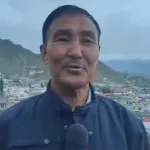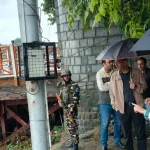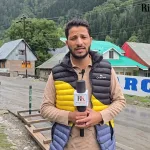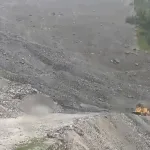Like other parts of the country, the Jammu and Kashmir is also very rich in archaeological and numismatic data. Thousands of coins were coming to light every year. I remember an old saying of Naba khar an old blacksmith of Devsar area of my native district of (Kulgam), He once told me that ‘when they were little boys, they used to collect “old paisa” ancient coins from their native Devsar Wooder (plateau) during the rainy days. The heavy rainfall would wash off and clean the surface of the slopes and make the metallic objects visible in the light and we as the villages boys would go to the wooder ( plateau) in search of the ‘old paisa’ ancient coins and collect it. Rehaman Sunuer an old goldsmith of Bijbehara area of district Anantnag revealed a similar story. He said to me that during rainy days we used to visit the Tutakshahi Wooder at Semithan and collected the old coins.
Semithan is the place which later on revealed the Grecian and Scythian coins in the systematic excavations of the year 1981, under taken by Archaeological Survey of India. Hundreds of ancient coins are reportedly found in Kashmir. More than seventy thousand coins are reported to have been preserved in Kashmir’s only museum at Srinagar. Every year coin hoards make their appearance here but unfortunately very few coins reach to safe hands while others either go out of the land or get melted in the workshops of gold smiths.
There are hardly any people who care for this heritage. I have seen very few people caring for historical value of coins. There are others who would always ask you about the antique value of these coins. The numismatic research in this land is hardly undertaken anywhere. It is only on individual levels that few researchers are doing their researches on archaeology and ancient history, while at institutional level the numismatic research is not taken any where in Jammu and Kashmir. Although this field has a very rich and interesting potential here and if researches are taken it would reveal interesting facts of ancient political economic, cultural, socials and technological history of Jammu and Kashmir.
- N. K. Bamzai in his monumental book ‘The history of Jammu and Kashmir’ writes, “If archaeological discoveries have thrown valuable light on the history of Kashmir, no less fruitful results have followed the close and systematic study of its old coins, gold, silver, copper and brass found in and outside the state”. It means that though today no researches have been done in this field but in old days many studies have been done on the subject. While tracing the origin of numismatic researches in Kashmir, like other parts of India, you would find that neither Kashmiris nor Indians and Pakistanis were involved in this research; once again you would find European experts forward on this track;
General Alexander Cunningham was the first to take up the coin study of Kashmir. During his stay in the Valley he collected a large number of ancient coins and as a result of close study of these coins and other finds, he was able to elucidate a series of important questions having a bearing on the chronological system of Rajtarangini and on the numismatic history of Kashmir. In a paper published in the numismatic chronicle for 1846 he communicated the results of his search for ancient Kashmirian coins and proved by their analysis the great value of numismatic evidence for the critical analysis of Kalhana’s Rajtarangni and other ancient records. He was the first numismatist who found a large number of Greek and Scythian coins on the banks of the Jehlum River in upper Jehlum valley.
Cunningham was followed in numismatic researches of Kashmir by C. J. Rodgers, Sir Aurel Stein and R.B.White Head. All these scholars were Europeans I could also see in one of the coin cabins of the museum several silver coins of Greek, Scythian and Parthian Satraps. The coins of following rulers were displayed in the cabin for the museum visitors:
1. Philip of Macedon.
- Alexander the Great.
- Alexander II of Macedon.
4.Diodotus.
5.Euthydemons.
6.Menander.
7.Apollodotus.
8.Hippostratus.
9.Lysis.
10.Azes.
11.Azelises.
12. Sapalarsis.
On the other hand during these times many coin collectors were born who made coin collection their hobby. Shairi Kashmir, late Peerzada Ghulam Ahmad Mehjoor has been one of the prominent coin collectors of the land. The legendary poet had already left the world for heavenly abode. Although I could not get a chance to meet his son Ibni Mahjoor as he has also left this world, but I got a chance to meet his younger grandson, Abdal Mehjoor and his son Atif Mehjoor. I found this duo, (the father and son), interesting in ancient history and in an informal communication with them they also showed interest in ancient coins. They told me the story of their great grandfather Peerzada Ghlam Ahmad Mehjoor. I learnt from them that Mahjoor had a good numismatic collection, where the majority of coins belonged to Greek and Scythian ages.
Basically, Peerzada Ghlam Ahmad Mehjoor was a Kashmiri popular poet of 20th century who worked in revenue department as Patwari. During his tenure as Patwari he had a very close public dealing mostly with village tenants and formers. Besides he was interested in antique collections with a passion in coin collection. He is learnt to have collected most of the coins from north western parts of Kashmir and had gathered a good collection of ancient Kashmir coins. (His son called Ibni Mehjoor is leant to have offered this collection to the state, but the deal could not materialize because no agreement was reached over the evaluation of the treasure and it is learnt that later on the collection reportedly was taken over by the National Museum new Delhi).
During my posting in the museum, I met several coin collectors and also had a chance to see their respective collections. I was very much influenced by Mr. Javid Ahmad Besati’s collection. He has selectively collected only few series, which include tribal series, Scythians, Greeks, Parthians, Kushans and Panch Marka. In his collection I still remember there were many coins of King Menander, Apollodotus, Lysis, Apostrates, Azes, Azelises, Gondphories etc. He has disposed of several hoards and kept with him only few selected coins of which I could see majority of coins belonged to Indo-Greeks and Scythians.
Mr. Javed Ahmad told me that he has purchased few hoards of Indo-Greeks coins, one of which carried the small square type coins of Apollodotus bearing motif of bull and elephant on either side of the coin. He also showed me few miniature figures of Gracie- Buddhist art. These were some goddesses in terracotta, one of which he told was the sculpture of Apollo, a Greek deity. He revealed that most of Grecian artifacts were reaching to him from south Kashmir. Javid Ahmad Basti lived in old city of Srinagar.
Another collector who was also a goldsmith by profession showed me several copper and silver coins of Scythian and Greek rulers. He was not a coin collector. He was basically a goldsmith. He purchased coins for his trade. He lived in Bijbehara area where he had an easy access to this material. He told me that he had sold thousands of coins to its buyers. Although he had no technical knowhow of differentiating various coin types, when I inquired I found he could well recognize the Scythian and Greek coins by their impressed motifs of Bust and standing deities and would charge more for such transactions.
One of my friends showed me a copper coin which he has collected from a plateau (wooder) near Dayalgam Anantnag. I could decipher that coin and found it was the coin of Indo-Greek King Artemidous. I could also once found a big heap of ancient copper coins in an olden shop at SafaKadal area of olden city of Srinager, which mostly carried the Bull / camel type coins of Kujula kadaphsis.
Apart from state museum there are other institutions as well, which have shown interest in preserving this state heritage. Kashmir University, for instance, has established Central Asian Museum in the Iqbal Library Complex at its Hazratbal campus. In this museum the university authorities have also set up a numismatic section where in Kashmir coins are displayed. In this section several Indo-Greek and Indo-Scythian coins are displayed. The coins of many Indo-Greek and Indo-Scythian Kings found in Jhelum valley were arranged in a coin cabin of this museum.
The Dogra art Museum Jammu and other several private museums and art galleries of Jammu city also house several such ancient coins. Although the tradition of collecting ancient coins in Kashmir valley is not popular but in Jammu it is very much followed there and several private museums and collections are upcoming which have also been involved in coin collection hobby.
(The author is a senior archaeologist and author. Feedback: [email protected])





